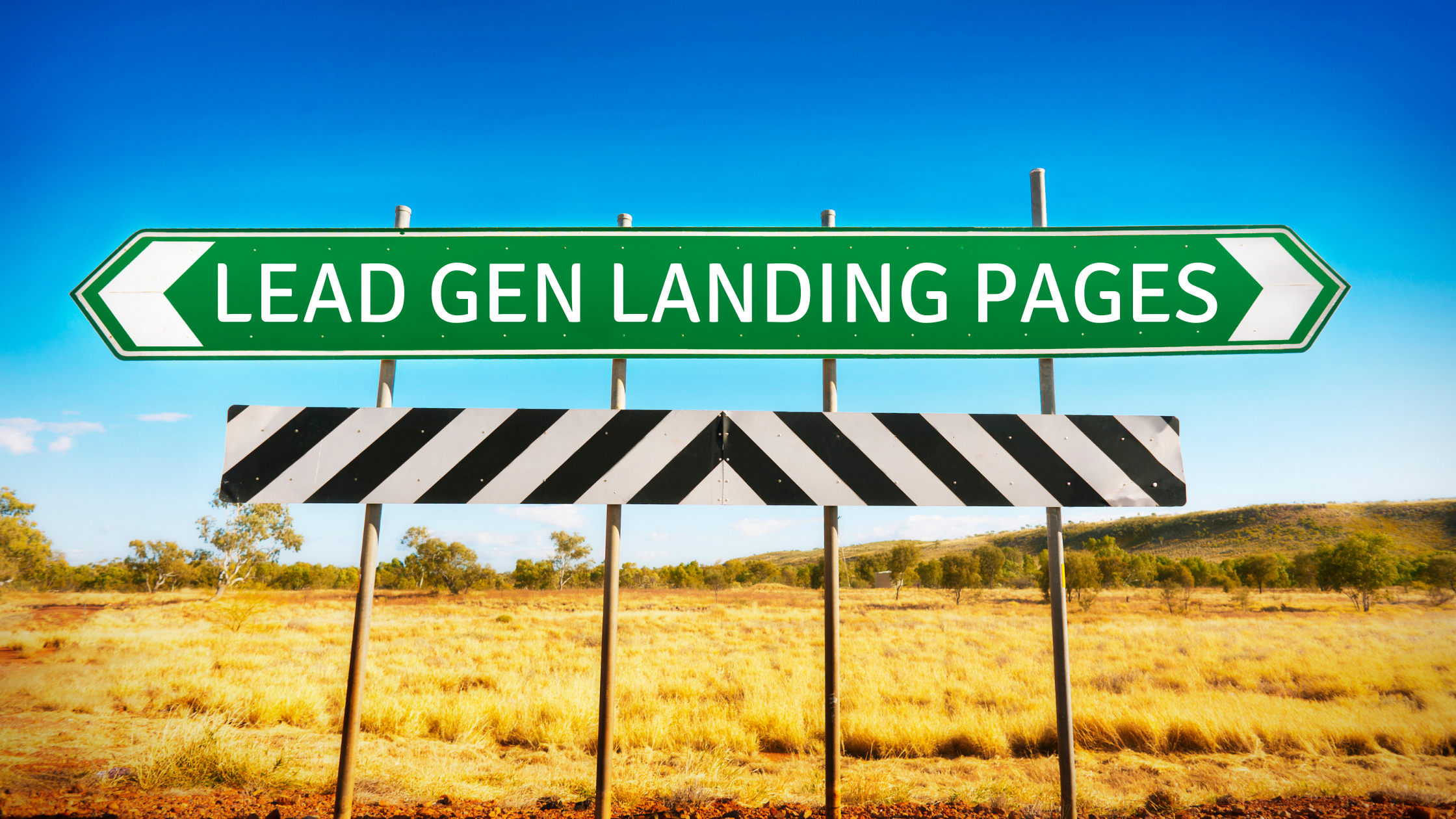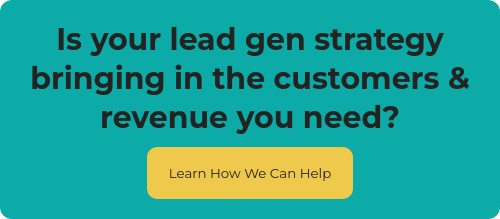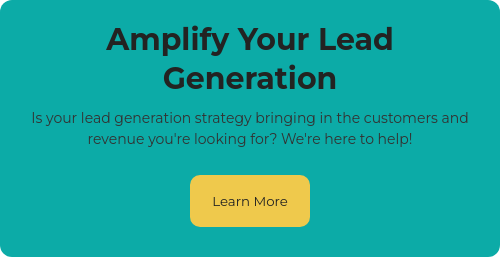Fantastic brand? Check. Killer product? Check. Tons of leads coming into your funnel? Check.
No conversions? Check. Wait…what?
Something doesn’t add up here. If you’ve got all the ingredients for a great recipe, but the final result falls flat, you need to take a closer look at what’s happening in the kitchen.
In this case, if you’ve got plenty of leads and a product they want, the real issue might be your landing pages. A terrible landing page is an excellent reason for good leads to jump ship. Stop giving them a reason, and instead, make them want to stick around.
Want to know how? We’ve got 26 tips to walk you through it.
What Is a Lead Generation Landing Page?
First, what’s a lead gen landing page? It’s a page you design specifically for a lead generation campaign. It typically includes an offer and a form, so visitors can give you their information in exchange for something they want, like a lead magnet.
A lead gen landing page is typically for bottom of the funnel leads who are warmed up and getting closer to conversion.
Cold leads are just coming into the funnel. Your job at that point is to pique their interest, warm them up, and get them onto your offer landing page. Once there, you begin the hard work of turning them from lead to conversion.
But the landing page itself plays a pivotal role in the process. Get in wrong, and your conversion rate will tank. Get it right, and you’ll have not just more customers but more long-term growth.
So what does a great lead gen landing page need? Let’s find out.
26 Lead Generation Landing Page Best Practices to Follow
Not all lead gen landing pages will look the same. They’ll differ based on the offer, the goal, the CTA, and the intended audience. But there are some best practices you can follow to create any successful lead gen landing page, and we’ve got them all listed right here:
#1: One goal per landing page
This one is so important but often forgotten. It’s tempting to put all your offers all over every page — someone might eventually click on one of them, right?
Nope. Pages with too many conflicting actions or offers just get overwhelming and confusing, so most visitors won’t take any action at all.
Instead, make sure your lead gen landing page has one offer and one clear call to action (CTA).
The CTA can appear multiple times on the same page, but make sure they all direct to the same steps. You can include a CTA button that pops up a form or directs to a separate page, but it’s often effective to include the form fill right on the page, as in the example above.
#2: A relevant offer
So, now we know the rule is one offer per page — but what is that offer? For lead generation, your offer will likely be some type of lead magnet — a (usually gated) content asset you ask leads to download.
The most important thing to consider when driving leads to your landing page is whether your offer is relevant to them. That means it should align with where they are in the funnel and provide something that’s valuable to them.
For instance, in the above example, that would be a great offer for Prospect A, who’s a marketer working on conversion rate optimization (CRO) for their brand. Prospect B, on the other hand, is a small business owner looking for some general info on email marketing. Both might have landed on the same site, but only one would find the offer relevant.
#3: Segment audience
Sure, you know your target audience and your buyer persona(s) pretty well, but even within those groups there will be smaller niche groups of leads with different pain points, goals, and needs.
This is where it becomes critical to segment your audience and create different versions of your landing page for each.
Once you tailor your offers to each audience segment, you’ll find that conversions increase.
This does require some extra legwork, of course, as you’ll need multiple offers and multiple landing pages. However, even minor tweaks to your lead magnet (to speak specifically to each segment) can make a big difference, and landing page templates make it much more manageable to create alternate versions.
#4: Landing page design does the heavy lifting
If you don’t do anything else, make your landing page look fantastic. It’s the first thing leads will notice when they land there, and we promise there’s nothing more off-putting than an unattractive, cluttered, or sketchy-looking landing page.
Fortunately, there are a bazillion (to be very technical) landing page templates out there and services that can walk you through every step of the design process.
That means you don’t have to be a designer to create an appealing landing page. But you do need to have a good eye. You’ll want to make sure the landing page matches the rest of your branding and doesn’t stand out like a sore thumb from the rest of your website.
If you don’t feel you can nail it, you might want to consider outsourcing it — it’s really that important.
#5: Design for usability
Okay, so disclaimer: Everything we said about landing page design above is true. But also, even the slickest, most attractive design won’t matter if the functionality of the page is a pain in the you-know-what.
Avoid the temptation to get too fancy with your landing page. Adding widgets and buttons and doo-dads might make you feel like you’re providing lots of opportunities for engagement and interaction, but really, it just overwhelms and confuses visitors.
Instead, make it as simple and easy as possible for leads to take the desired action on a page.
As you see above, you’ve got a landing page with very minimal navigation, a clean and basic (but appealing) design, and one single action to take.
For your visitors, it doesn’t get easier than that.
#6: Remove navigation and distractions
Speaking of navigation, if it’s at all possible to remove it, do so. Or, at the very least, minimize it.
You want your page to be clean, free of distractions, and not confusing to visitors.
Keep the basics, like your homepage, contact page, and anything else that might be necessary to the user experience. But get rid of everything else but the offer.
If you’re worried that leads who are interested in learning more about your brand won’t be able to get further information — don’t. You’ll have plenty of chances to follow up with them after they convert and give you their contact information.
Also, you likely have some key navigation at the bottom of the page, so don’t sweat it.
#7: Keep important information above the fold
“Above the fold” is an old publishing phrase used in the newspaper industry. Breaking news and major stories needed to appear on the top half of the paper — above where it would be folded — so it was more visible and eye-catching.
How does that translate in the digital age? It sounds old school, but there’s still an “above the fold.” Basically, it means you put your most critical information near the top of the page — where it will appear right smack in the middle of a laptop screen, without any scrolling.
It doesn’t mean you can’t have any information below the fold. But know that your leads aren’t guaranteed to scroll through the whole page, so you want your main idea right at eye level.
#8: Benefit-driven headline
There are too many crappy headlines in the world; don’t be the brand that adds another one.
Headlines are important because they appear above the fold and are typically the first thing your visitors read on the page.
You’ll want your headline to show the main benefit of your offer right near the start. Keep these considerations in mind:
- Make it short. Headlines should ideally be around 100 characters.
- Benefit first. What does your audience want/need from your offer? What do they get out of it?
- Pain points. What does your offer solve for them?
- Numbers. Listicles, countdowns, top tens, etc., are always popular choices.
#9: Craft a clear and actionable call to action button
There’s really a science to creating an effective CTA. The size, language, and even color all play an important role in whether or not your leads click.
Most importantly, though, you want your CTA to be extremely clear and concise so they know exactly what they’re getting when they click.
For lead gen, your CTAs will most often direct them to download a lead magnet, subscribe to a newsletter, complete a form, or sign up for a free trial or demo.
#10: Use directional and visual cues
This is one of those tricks used in the industry to subconsciously direct visitors to the info you most want them to see. Directional cues involve image placement — basically, you put an image close to where you want visitors to click, which automatically pulls their attention in that direction.
But you can be even subtler about it, using a model who’s looking in the direction of the form or CTA, as in the example below.
Our eyes are drawn to where the model is looking, which just happens to be where you need to fill out your information.
#11: Use attractive images to support design and text
So, you probably wouldn’t put a picture of a wintry landscape on a landing page that’s advertising your guide on starting a summer rental business, right?
Make sure your visuals are attractive but also relevant to what you’re offering. Take, as an example, the digital nomad/travel site below. The hero image on the site is actually one in a carousel of images depicting gorgeous travel hot spots. Beautiful and relevant.
When you have relevant and appealing images paired with your information, visitors are more likely to retain the details you’re telling them.
#12: Show your product in action with a video
Video content is extremely effective, especially when it comes to lead gen. It can also be a great element to include on your lead gen landing page.
Video offers a great opportunity to showcase how your product works or give tips on how to get the most out of it. It gives visitors a reason to stay on the page, and it might also give them the nudge they need to convert.
Keep video content above the fold, but make sure it doesn’t compete with your offer and CTA.
#13: Optimize landing page forms
There’s definitely an art to designing forms for landing pages. Most often, the general rule is the easier, the better.
There are tons of form builder tools out there that will walk you through the process, but there are a few tips you can keep in mind:
- Flow is important. Linear forms are usually best, top to bottom, rather than those that zig-zag.
- Keep it short. Only ask for the info you really need, and skip the rest.
- If you do need more details, make the questions multiple-choice.
- Don’t forget an opt-in checkbox so they know they’ll be receiving emails from you.
#14: Give readers a reason to say yes
Make sure you’re prominently indicating the benefits of your product or service on your landing page.
Of course, you can’t keep all the information above the fold as it would be too cluttered and overwhelming, but you should, at minimum, have the primary benefit included in your headline.
From there, you can include additional benefits further down the page, where that’s a comparison chart, a list, or relevant testimonials.
Ultimately, you want to create messaging on your page that your visitors just can’t say no to.
#15: Ensure message match and consistency with the conversion funnel
Speaking of messaging, it doesn’t just have to be clear, concise, and motivating (which are all important) — it also needs to align with where your leads are in the funnel.
For instance, you wouldn’t want to offer a free trial to leads just at the very top of the funnel, as they’re nowhere near ready to take that step yet.
At the same time, you wouldn’t want to ask bottom of the funnel leads to give you their information in exchange for a basic checklist, as they’re already well past that point.
Make sure your offer and all the messaging that accompanies it is a good match for the leads you want to acquire.
#16: Use bullet points and avoid large blocks of text
You’ve already seen us do this several times within this very article.
No one wants to read a wall of text, and that can be a major reason for increasing bounce rates. Instead, break up text with headers (H2s and H3s, etc.), lists, and bullets to make lengthy pages or articles easy to scan.
If you aren’t into using bullets, you can also try breaking up long text with:
- Checkmarks
- Icons
- Avatars
- Emojis
Get creative with it!
#17: Reduce friction with social proof and trust badges
You want to make sure your leads (especially those who haven’t been exposed to your brand before) know that you’re legit. That’s why you need both social proof and trust signals.
Social proof is anything that demonstrates you’re a real, authentic, and reputable brand. It might be an endorsement from an industry influencer, a guest post on a reputable blog, or an award from a recognized organization, as you can see on our FPS homepage.
Toward the bottom of the page, you’ll find more social proof as we indicate clients we’ve worked with in the past.
All of these serve as trust signals — usually visual cues that work subconsciously to instill trust in your audience.
Beyond adding trust signals and social proof to your landing page, you’ll also want to add a few other best practices, like making your privacy policy easy to find and ensuring all opt-in details are clearly outlined.
#18: Tap into FOMO with limited offers
Limited-time deals and exclusive sales have long been the bedrock of traditional advertising, and there’s good reason for that. Twenty years ago, we didn’t have a catchy phrase for it, but now we do: FOMO (fear of missing out).
No one wants to feel as if they’ve been excluded from something amazing or something their peers, colleagues, or social network are doing.
It was a great tactic decades ago, and it still works for demand generation today.
Even if your offer doesn’t necessarily expire, you can still put a time limit on it to encourage more sign-ups.
#19: Optimize your landing pages for mobile users
Mobile usage is on the rise, and the trend isn’t slowing down. Now, a majority of mobile users access the internet from their smart devices and often sign up for deals or make purchases straight from their devices.
Make sure your landing page looks just as good on mobile as it does on desktop if you want to maximize conversions.
Forms are especially tricky on mobile devices, which is why it’s important to make them as simple and easy to fill out as possible.
#20: Hire a conversion specialist to write landing page copy
CRO (conversion rate optimization) is both an art and a science. There are tactics you can easily DIY to improve your likelihood of conversion, but there are other considerations that take more skill and more time.
Landing page copy (if you want it to be effective) isn’t something you can throw together as an afterthought. It takes a lot of knowledge about what language converts and how to weave it together in a way that is interesting, informative, and motivating.
Here are some tips for creating high-converting copy:
- Keep all copy short and sweet.
- Break it up with bullets and headers.
- Use action-oriented language.
- Stay away from passive voice.
- Incorporate priority keywords in headers.
We could continue on with this list much longer, but in the end, what is actually most effective is to seek support from an experienced lead gen agency, consultant, or copywriter. When it comes to conversion, it’s a very specific skill set and not something you can fake ‘til you make it.
#21: Include testimonials from happy customers
So, you’ve wowed some customers with your product or service, and they’re so pleased they want to tell the world — great work!
Testimonials are so valuable when included on your lead gen landing pages — just keep a few things in mind:
- Use testimonials that align with the specific offer.
- Ask customers before using their review or recommendation (if you get it from a third-party site).
- Reward or incentivize customers to give you a testimonial.
- Display testimonials prominently along with the offer.
#22: Include your privacy policy
Having a privacy policy is pretty much standard operating procedure these days.
Your privacy policy is more than legal mumbo jumbo — it acts as a trust signal, but it also offers important protection for your brand (especially now that data privacy is so critical in the marketing realm).
Make sure your privacy policy is easy to find on your landing page, whether it’s in your bottom nav or you ask leads to acknowledge they’ve read it during the form fill process. You may also want to include a brief line elsewhere in a relevant spot on the page.
#23: Appeal to emotion
If you think you’re going to give your leads all of the facts and statistics they need to make a purchase decision, you may want to think again.
Data has its place, of course (and a very important place), but when it comes to lead generation, you want to stick with tried and true advertising methods — and the general wisdom is that emotions are more motivating than logic.
Once you use emotion to win over your leads, you can follow up with the data and statistics they want. But first, you’ve got to hook them where it counts — the heart.
#24: Use persuasive words to inspire action
As we’ve mentioned, effective lead gen, high-converting copy is usually action-oriented. You’ll want to use persuasive language in your copy if you want your leads to take the desired action.
Persuasive words include:
- Free
- New
- Instant
- Exclusive
- Now
- Why
We could go on, but hopefully, you get the point. Just remember to use the words above judiciously. Using “FREE!!!!” too often on your landing page can actually cheapen your offer and make it less appealing.
Use these words in key locations, just don’t overdo it.
#25: A/B test your landing pages
This is one of the most crucial steps to effectively optimizing your lead gen landing pages.
A/B testing, or split testing, is when you create two versions of your landing page with one element changed in order to see which performs better.
The most important thing to remember about A/B testing is that you only test one element at a time. Otherwise, you won’t know which change impacted the results. The best way to do it is one single change at a time, one element at a time until you reach a winning combination of on-page elements.
#26: Use behavior tracking tools to understand how visitors interact with your landing page
Think you’ve got a great landing page, but you’re not getting the conversions you want? If you’ve done all the A./B testing and optimized in various other ways but you still aren’t seeing leads take the action you want them to take, look into using behavior tracking tools like these:
- Heat maps: Shows you exactly where visitors click, how far they scroll and when they engage with your page.
- Session recording: This software essentially captures a video of how users interact with your page, so you can see when they scroll, swipe, or click — or when they jump ship.
- Survey: Use automated software to get feedback directly from visitors so you know what they liked (and didn’t) about your page.








